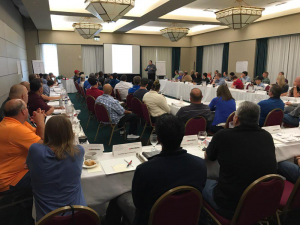The unprecedented shale based crude production (> 5 million bpd) from tight oil formations (Eagle Ford, Permian, etc) are why the U.S. has become the swing producer to the global market. It’s no secret that U.S. refiners, particularly those along the Texas and Louisiana Gulf Coast continue to process higher volumes of these domestic crudes, even though many of them were originally designed to process heavier imported crudes from Venezuela, Canada, Arab Heavy and other opportunity type feedstocks. However, many of these paraffinnic shale-based crudes, due to their unique waxy properties, continue to cause problems with primary conversion units, including the distillate-configured hydrocracker. The unique properties and low sulfur content of shale oil can lead to cold flow, water separation, and lubricity issues in distillate products.
While it has been reported that the typical Gulf Coast refiner processes as much as 50 different types of crudes annually in a fixed refinery configuration, it’s these fixed process configurations that need to be optimized for processing significantly higher volumes of paraffinic crudes to meet growing demand for diesel, gasoline and jet fuel. Diesel and gasoline exports to Latin America, along with jet fuel prices at a 6-yr high ($4.55/gallon) due to busy air travel in a booming economy, are why many domestic refiners are operating at greater than 95% utilization rates. The problem is that waxy shale crudes make it challenging to convert to jet fuel.
Shale crudes have fewer contaminants than the heavier imported crudes, but are nonetheless causing their own unique problems, including crude blending capability issues, furnace and heat exchanger fouling, yield selectivity changes and product quality issues, etc. It appears that contending with catalysts and equipment fouling are the top concerns. For refinery product objectives, such as Euro V quality diesel, a range of suppliers can be called in to deal with tight oil feed properties. They can expedite determining the processing steps and equipment required to upgrade these feeds. For example, global hydrocracking catalyst and technology supplier Haldor Topsoe incorporates a series of inter-related processing steps to “protect” the hydrocracking unit in the monetization of these bespoke feeds.
Considering that output from the Permian is forecast to more than double between 2017 and 2023, jumping to 5.4 million barrels a day (according to a new estimate from IHS Markit), a dedicated shale feedstock processing strategy focused on the region’s crude properties is imminent. Topsoe’s process typically includes a step for filtering solids and other contaminants, followed by a guard section to protect the catalyst and equipment from fouling due to olefin polymerization. A hydrotreating step is then deployed to saturate olefins, remove arsenic, convert oxygenates and organic chloride, and achieve hydrodesulfurization (HDS) at low pressure in preparation for feeding to a high pressure hydrocracker that can optimize yield of high quality diesel and other products, such as LPG, naphtha, unconverted oil (UCO to FCCU, etc.).
Considering all the processing steps added upstream from the hydrocracking reactor (in order to protect it), it appears that the Nelson Complexity Index (NCI) rating for those refiners focused on a shale crude diet may be approaching the complexity of those refiners processing heavy, high Concarbon residue crudes, such as the PBF Delaware City refinery processing heavy slate crudes (NCI = 11.3).
According to a recently released TCGR intelligence report, “Business Shifts in the Global Catalytic Process Industries 2015 – 2021,” the refining industry’s growth is being driven by hydrocracking advances and revamps along with environmental regulations and shifting transport fuels demand, primarily from gasoline and diesel. The TCGR report also noted that new technology continues evolving to improve the use of changing feedstocks, including light tight oil (LTO) and shale gas to produce fuels with zero sulfur and other mandated product specifications. So, it stands to reason that additional dialogue and forums focused solely on the conversion technology, such as hydrocracking needed to process shale crudes from a swing producer like the U.S. is imminent.








Leave a Reply
You must be logged in to post a comment.